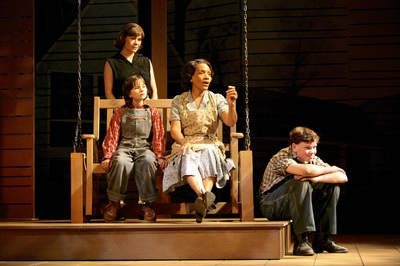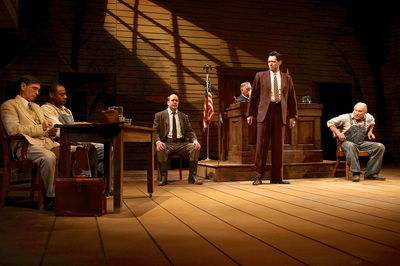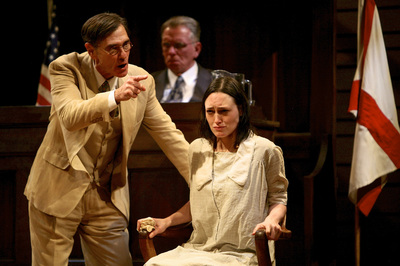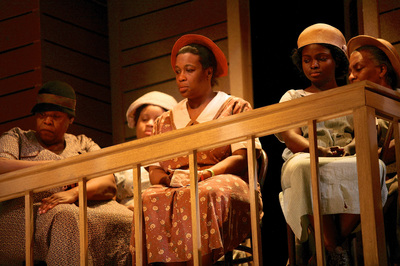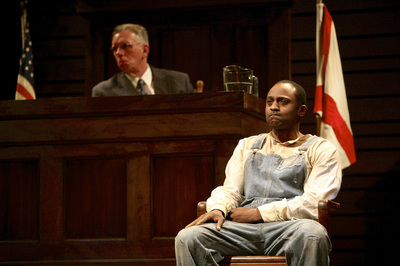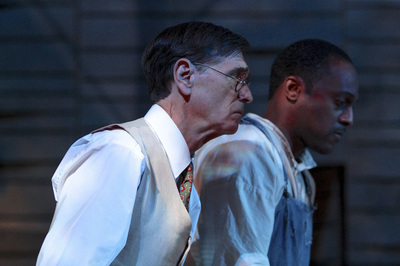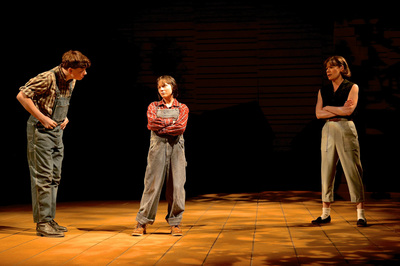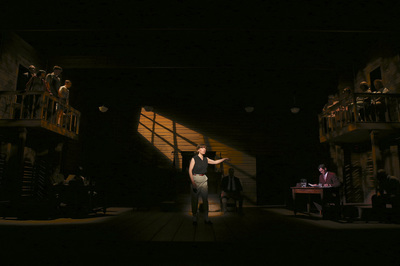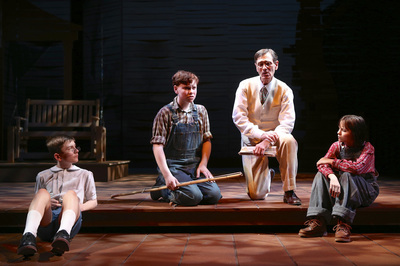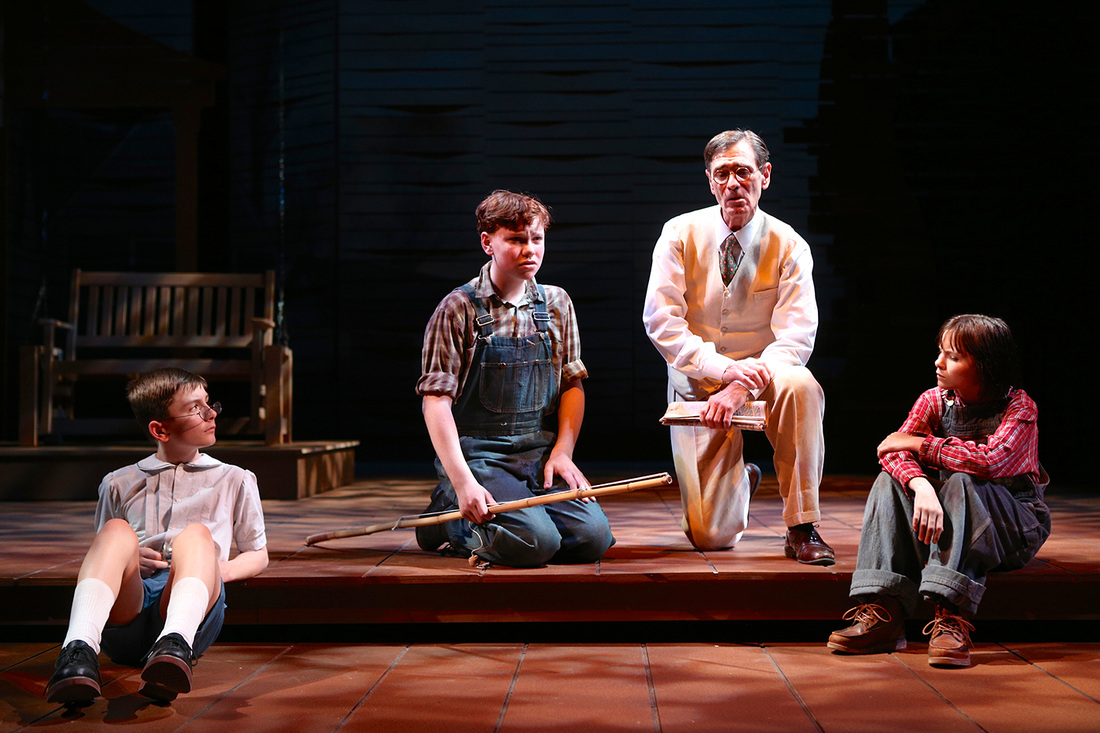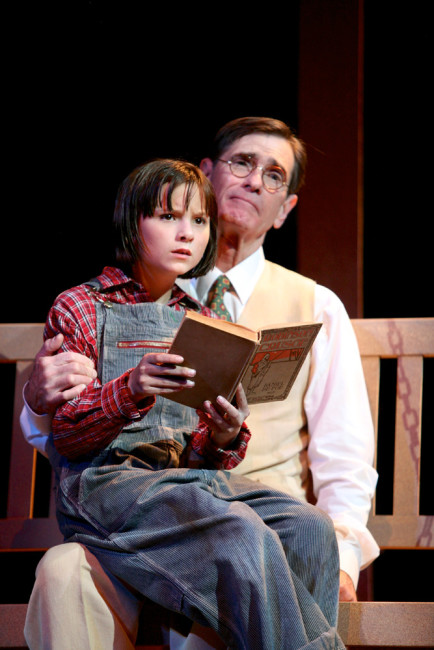|
|
Adapted by : Christopher Sergel
Based on the Book by : Harper Lee Directed by : Timothy Bond February 24 - March 26, 2016 Description Harper Lee's classic American story of courage and justice. In a small Alabama town, a black man, Tom Robinson, stands falsely accused of raping a white woman. Many townspeople would see him condemned, but attorney Atticus Finch defends Tom and demands justice. Through the trial, Atticus' children Scout and Jem and their friend Dill come face to face with realty of racism in their small town. Dr. Martin Luther King reminds us, “Injustice anywhere is a threat to justice everywhere.” This inspiring truth underlies To Kill a Mockingbird. "Enchanting, heartfelt." - Daily Express "Stirring and timely." - Chicago Reader |
|
|
The performances in Syracuse Stage’s “To Kill a Mockingbird” outweigh its abundance of physical space.
From left, Anthony Cawley, Matthew Caraccioli, Mark Murphey and Sera Bullis in Syracuse Stage’s "To Kill a Mockingbird." Michael Davis photo
Audiences enter a production of To Kill a Mockingbird thinking, rightly or wrongly, that they know all its secrets. Harper Lee’s 1960 Pulitzer Prize-winning novel has been read so frequently and studied so thoroughly that there’s hardly an adult American who does not, for example, know the identity of Boo Radley.
Popular admiration for the noble defense lawyer Atticus Finch is so great that countless families have named their sons for him. At least until last year. When we enter Syracuse Stage’s production of Christopher Sergel’s adaptation of Mockingbird, we expect to execrate the outrages of our Jim Crow past but feel elevated that one Alabama lawyer rose above the moral muck.
Sergel’s 1970 stage version is not the book, although it is clearly influenced by Horton Foote’s Academy Award-winning script for the 1962 Gregory Peck movie adaptation. So we can dismiss last year’s bombshell revelation that Lee’s original draft of the story, Go Set a Watchman, presents a vastly different characterization and tone. Even though, assuredly, it is on everyone’s mind. Atticus Finch’s words are still inspiring.
From left, Anthony Cawley, Matthew Caraccioli, Mark Murphey and Sera Bullis in Syracuse Stage’s "To Kill a Mockingbird." Michael Davis photo
Audiences enter a production of To Kill a Mockingbird thinking, rightly or wrongly, that they know all its secrets. Harper Lee’s 1960 Pulitzer Prize-winning novel has been read so frequently and studied so thoroughly that there’s hardly an adult American who does not, for example, know the identity of Boo Radley.
Popular admiration for the noble defense lawyer Atticus Finch is so great that countless families have named their sons for him. At least until last year. When we enter Syracuse Stage’s production of Christopher Sergel’s adaptation of Mockingbird, we expect to execrate the outrages of our Jim Crow past but feel elevated that one Alabama lawyer rose above the moral muck.
Sergel’s 1970 stage version is not the book, although it is clearly influenced by Horton Foote’s Academy Award-winning script for the 1962 Gregory Peck movie adaptation. So we can dismiss last year’s bombshell revelation that Lee’s original draft of the story, Go Set a Watchman, presents a vastly different characterization and tone. Even though, assuredly, it is on everyone’s mind. Atticus Finch’s words are still inspiring.
Mark Murphey (right) and Sera Bullis in Syracuse Stage’s To Kill a Mockingbird.
Michael Davis photo | Syracuse New Times
More pertinent is Malcolm Gladwell’s 2009 article in The New Yorker, calling out author Lee’s links to progressive segregationist (not an oxymoron) Alabama Gov. Jim Folsom. He thought an enlightened administration could save separate-but-equal. Gladwell, who is of mixed race, is troubled that blacks rarely get to speak in their own voices in the book, and questions its high place in the hearts of those championing racial justice.
Director Timothy Bond scheduled To Kill a Mockingbird last year before the Watchman news broke, and in his curtain speech reaffirmed its high place in his personal pantheon. His casting of several veterans of the Oregon Shakespeare Festival, his former artistic home, indicates that he was looking for performers embodying his own vision.
This works well with Mark Murphey in the most important role, that of Atticus. Banished is the ponderous Lincolnesque Atticus of Gregory Peck, a much loved performance that landed Peck’s image on a commemorative stamp. Bond and Murphey want us to hear the familiar lines anew, as if for the first time. Murphey walks with a lighter tread. The gloss of the title on the taboo against killing the gentle mockingbirds is more effective when it is not preceded by a drum roll.
Similarly, Murphey’s Atticus has a refined sense of fatalism in exposing the trumped-up charges against innocent non-rapist Tom (Landon G. Woodson). He is determined that the truth be known even if the jury and the townies will not act on it. He is neither a martyr nor an absurdist. Falsehood will be exposed regardless of what happens to Tom. It’s the best that can be wrested from a hideous outrage.
Other casting choices enhance Bond’s vision, which we have noticed over the last seven years allows even the worst of villains a moment of saving grace. Tall John Keabler, with leading-man good looks, greatly humanizes Mr. Gilmer, the prosecutor. Later, doubling up as Boo, Keabler has the muscle to carry adult-sized Jem (Matthew Caraccioli) back into the house. Similarly, Liam Craig as the lawman Heck Tate is anything but the enforcer of injustice.
Where Bond’s To Kill a Mockingbird fails to make our pulses race is in its use of space. There is too much of it. William Bloodgood’s rough-wood set design effectively evokes the darkness of a country night, but two small balconies at left and right, originally attached to residences, must also serve for Colored-only gallery seating during the trial.
Bond hired and costumed 12 local African Americans to sit there and coached them through reactions that we barely see. They are joined by veteran Syracuse Stage player William J. Hall Jr. (The Boys Next Door, Two Trains Running) as Reverend Sykes and even with his enormous presence we barely see him. Even sound designer Michael Keck’s crowd noises are not enough to make up for what’s missing.
Similarly, we don’t get to see the faces of the lying daughter and father team of Mayella (Rachel Towne) and Bob Ewell (John Pribyl) during their exposure. Towne, a recent graduate of the Syracuse University Drama Department, is masterful during Mayella’s testimony: paranoid, snaky but somehow pathetic. As Bob, Pribyl, last seen here as Bottom in A Midsummer Night’s Dream, has a certainly lightness of delivery not in line with a killer in the making. Nonetheless, both expressive players are tucked way over at stage left, almost in the wings, when the accused Tom tells of his pity for Mayella and we learn just how her eye happened to be blackened.
Barbra Wengerd’s narrator informs without intruding. Her perfect regional accent, coached by Celia Madeoy, sets the tone, urgency without nostalgia, and never gives away more than she should. Madeoy also appears commandingly as the haughty Mrs. Dubose, remnant of a dozen characters in the book who define the conventional wisdom of the town. As the graceful household servant Calpurnia, Perri Gaffney implies that blacks in the Finch household may speak as equals and are not separated.
To Kill a Mockingbird is unusual in that so much of the weight in the first act must be carried by youthful nonprofessionals. Sergel’s adaptation was aimed at school groups and only later was popular with regional theaters.
Maybe not professional but experienced. Sera Bullis as Scout had previously played Gavroche in two productions of Les Miserables and looks perfect in overalls. Matthew Caraccioli delivers a nuanced Jem, an otherwise thankless role, and speaks with the sharpest projection of the three young performers. Anthony Cawley’s more restrained but wise Dill may know that he is based on Lee’s childhood pal who grew up to be Truman Capote.
To Kill a Mockingbird, producing artistic director Timothy Bond’s second-to-last assignment at Syracuse Stage, is his last word on the subject of race in America.
To Kill a Mockingbird continues Thursday, March 3, 7:30 p.m.; Saturday, March 5, 3 and 8 p.m.; Sunday, March 6, 2 p.m.; and Wednesday, March 9, 3 p.m.; at Syracuse Stage, 820 E. Genesee St. The show runs through March 26.
Michael Davis photo | Syracuse New Times
More pertinent is Malcolm Gladwell’s 2009 article in The New Yorker, calling out author Lee’s links to progressive segregationist (not an oxymoron) Alabama Gov. Jim Folsom. He thought an enlightened administration could save separate-but-equal. Gladwell, who is of mixed race, is troubled that blacks rarely get to speak in their own voices in the book, and questions its high place in the hearts of those championing racial justice.
Director Timothy Bond scheduled To Kill a Mockingbird last year before the Watchman news broke, and in his curtain speech reaffirmed its high place in his personal pantheon. His casting of several veterans of the Oregon Shakespeare Festival, his former artistic home, indicates that he was looking for performers embodying his own vision.
This works well with Mark Murphey in the most important role, that of Atticus. Banished is the ponderous Lincolnesque Atticus of Gregory Peck, a much loved performance that landed Peck’s image on a commemorative stamp. Bond and Murphey want us to hear the familiar lines anew, as if for the first time. Murphey walks with a lighter tread. The gloss of the title on the taboo against killing the gentle mockingbirds is more effective when it is not preceded by a drum roll.
Similarly, Murphey’s Atticus has a refined sense of fatalism in exposing the trumped-up charges against innocent non-rapist Tom (Landon G. Woodson). He is determined that the truth be known even if the jury and the townies will not act on it. He is neither a martyr nor an absurdist. Falsehood will be exposed regardless of what happens to Tom. It’s the best that can be wrested from a hideous outrage.
Other casting choices enhance Bond’s vision, which we have noticed over the last seven years allows even the worst of villains a moment of saving grace. Tall John Keabler, with leading-man good looks, greatly humanizes Mr. Gilmer, the prosecutor. Later, doubling up as Boo, Keabler has the muscle to carry adult-sized Jem (Matthew Caraccioli) back into the house. Similarly, Liam Craig as the lawman Heck Tate is anything but the enforcer of injustice.
Where Bond’s To Kill a Mockingbird fails to make our pulses race is in its use of space. There is too much of it. William Bloodgood’s rough-wood set design effectively evokes the darkness of a country night, but two small balconies at left and right, originally attached to residences, must also serve for Colored-only gallery seating during the trial.
Bond hired and costumed 12 local African Americans to sit there and coached them through reactions that we barely see. They are joined by veteran Syracuse Stage player William J. Hall Jr. (The Boys Next Door, Two Trains Running) as Reverend Sykes and even with his enormous presence we barely see him. Even sound designer Michael Keck’s crowd noises are not enough to make up for what’s missing.
Similarly, we don’t get to see the faces of the lying daughter and father team of Mayella (Rachel Towne) and Bob Ewell (John Pribyl) during their exposure. Towne, a recent graduate of the Syracuse University Drama Department, is masterful during Mayella’s testimony: paranoid, snaky but somehow pathetic. As Bob, Pribyl, last seen here as Bottom in A Midsummer Night’s Dream, has a certainly lightness of delivery not in line with a killer in the making. Nonetheless, both expressive players are tucked way over at stage left, almost in the wings, when the accused Tom tells of his pity for Mayella and we learn just how her eye happened to be blackened.
Barbra Wengerd’s narrator informs without intruding. Her perfect regional accent, coached by Celia Madeoy, sets the tone, urgency without nostalgia, and never gives away more than she should. Madeoy also appears commandingly as the haughty Mrs. Dubose, remnant of a dozen characters in the book who define the conventional wisdom of the town. As the graceful household servant Calpurnia, Perri Gaffney implies that blacks in the Finch household may speak as equals and are not separated.
To Kill a Mockingbird is unusual in that so much of the weight in the first act must be carried by youthful nonprofessionals. Sergel’s adaptation was aimed at school groups and only later was popular with regional theaters.
Maybe not professional but experienced. Sera Bullis as Scout had previously played Gavroche in two productions of Les Miserables and looks perfect in overalls. Matthew Caraccioli delivers a nuanced Jem, an otherwise thankless role, and speaks with the sharpest projection of the three young performers. Anthony Cawley’s more restrained but wise Dill may know that he is based on Lee’s childhood pal who grew up to be Truman Capote.
To Kill a Mockingbird, producing artistic director Timothy Bond’s second-to-last assignment at Syracuse Stage, is his last word on the subject of race in America.
To Kill a Mockingbird continues Thursday, March 3, 7:30 p.m.; Saturday, March 5, 3 and 8 p.m.; Sunday, March 6, 2 p.m.; and Wednesday, March 9, 3 p.m.; at Syracuse Stage, 820 E. Genesee St. The show runs through March 26.

Theatre Review: ‘To Kill a Mockingbird’ at Syracuse Stage
Natasha Ashley
The latest production being presented at Syracuse Stage is the Pulitzer Prize-winning classic American tale To Kill a Mockingbird. Adapted by Christopher Sergel from Harper Lee’s novel and brilliantly directed by Producing Artistic Director Timothy Bond, the Syracuse Stage production brings the classic piece of American literature to life in a real and emotion-filled way.
. . .a production that is not to be missed.
This familiar story takes place in a small fictitious town in Alabama called Maycomb during the Depression and examines “the destruction of childhood innocence in a world poisoned by fear, hatred, and racial prejudice.” This is accomplished with a narrating device. Jean Louise (Barbra Wengerd) – known as “Scout” (Sera Bullis) when she was younger – tells us the story of the small town lawyer Atticus Finch (Mark Murphey) defending an innocent African American man named Tom Robinson (Landon G. Woodson) who has been charged with raping a white woman. In representing Robinson, Atticus Finch is faced with exposing himself and his family to the anger of a very prejudice white community. Finch has raised his children with a sense of morality and justice. The children watch the Tom Robinson’s trial and witness firsthand the injustice stemming from deep racial inequality. They are innocent children no longer.
Barbra Wengerd portrays the narrator Jean Louise or the adult Scout with such precision and maturity and really represents the growth that Scout experienced when she saw how unfair the world can be when these events unfolded in her hometown. As Jean Louise watches her younger self discover gifts left in an old tree with her brother Jem (Matthew Caraccioli) or see the goodness in all the people in her small town community – essentially reliving her own childhood – you can see the longing in her face. With perfect facial
expressions and impressive monologues, Wengerd certainly captures the heart of the mature Scout perfectly. Sera Bullis, portraying the younger Scout, is her acting match. A true and natural talent with acting abilities that defy her age, she gives a spot-on performance of a young tomboyish girl coming to terms with how the world really is, and maturing. It’s clear that Bullis is intelligent and mature herself, and shines through in this character that has similar qualities.
As Scout’s older brother Jem, Matthew Caraccioli is nothing short of amazing on stage. He was recently in Syracuse Stage’s musical production of Peter Pan as John and it is wonderful to see him in a very different role. His natural talent shines through every moment he is in the spotlight and he excels at demonstrating his character’s arc throughout the story. In the first Act, we see a football-loving and daring boy. As injustice swirls around him, he experiences major personal growth as he moves toward adulthood. Caraccioli makes clear this shift in act two.
Mark Murphey is, likewise, exceptional as Atticus Finch, Scout and Jem’s widower father. Finch’s dry sense of humor pervades his fabulous line delivery and all of his physical mannerisms, but what really is excellent is how he fully captures his character’s intelligence and commitment to racial equality during the trial in the second act. Murphey excels in the deeply powerful role.
Other standouts include Anthony Cawley as the highly imaginative Dill. He perfectly represents childhood innocence with his wide-eyed and excited performance, especially when delivering lines about his fascination with Boo Radley (brilliantly played by John Keabler), a recluse neighbor in the small town. In contrast, John Pribyl gives a commanding performance as the town drunk Bob Ewell and represents the hate that exists in the south. Rachel Towne really captures Mayella Ewell’s loneliness and unhappiness. Mayella is the young woman that is abused by her father and wrongfully accuses Tom Robinson for the crime and Towne fully immerses herself in that tough situation. Perri Gaffney gives a spunky and stern performance as Finch’s cook Calpurnia. She serves as the Finch children’s link between the white world, and the black community. As Mrs. Dubose, Celia Madeoy is the perfectly sassy, know-it-all southern woman.
The rest of the highly professional cast members also truly embody their characters and make clear the deeper meaning behind each of them. Celia Madeoy does well to ensure each cast member is proficient with the southern dialect.
The performances aren’t the only asset in this production though. William Bloodgood’s beautiful set captures a Southern town perfectly. Farmhouses easily transform into the courthouse and all transitions are smooth and effortless. Suzanne Chesney’s costumes give us further insight into the characters. Michael Keck’s compositions evoke deep emotion. All of the artistic elements add to the production.
Overall, this is a production that is not to be missed. The poignant story of courage and justice of To Kill a Mockingbird is truly an American classic and the present production is real, emotional, and beautifully done.
Running Time: Approximately Two and half hours with one fifteen minute intermission.
Guidance: Suitable for more mature children due to some adult themes.
To Kill a Mockingbird plays at Syracuse Stage through March 26, 2016.

Syracuse Stage to Present TO KILL A MOCKINGBIRD
by BWW News Desk
February 11
Harper Lee's classic American tale of courage and justice takes the stage as Syracuse Stage presents TO KILL A MOCKINGBIRD, February 24 - March 26, directed by producing artistic director Timothy Bond.
Through the familiar story of small-town lawyer Atticus Finch, his daughter Scout, and the falsely accused Tom Robinson, the stage adaptation by Christopher Sergel, like its source material, examines the destruction of childhood innocence in a world poisoned by fear, hatred, and racial prejudice.
Lee's iconic story has had an influence on Bond, as an African American man and as an artist. "TO KILL A MOCKINGBIRD is a book and a story that has always moved me," says Bond, who began considering adding the play to a Syracuse Stage season 18 months ago. Bond sees the play as a way of addressing national issues of xenophobia and racial injustice. These prejudices have always been around but have seemingly exploded recently, demonstrating that they have never been an issue that only exists in the South. In casting the production, Bond found that his cast shared his opinion on the importance of mounting the play in these times. "I think the themes that the play and the original story that Harper Lee is touching on are still incredibly relevant," says Bond, "I'd say tragically relevant, today."
Bond conducted extensive auditions for the roles of the three child characters at the center of the story, particularly the character of young Scout. In order for the roles to resonate as truthfully as the adult characters, Bond needed child actors with a strong sense of emotional maturity that would allow them to better comprehend such complicated themes. In casting local child actors Sera Bullis, Matthew Caraccioli, and Anthony Cawley, Bond found the qualities that he was looking for. These actors would need to read the book as well as to learn about the Jim Crow South and gender roles in the 1930s, as a way of understanding the town of Maycomb. "What makes someone mature is experience," says Bond. "So I wanted kids that brought the right experience."
Along with the three children, the show features a cast of veteran stage actors and 12 members of the local community who will fill out the gallery in the courtroom.
Bond is currently in his last season as producing artistic director at Syracuse Stage. The upcoming play The Christians will be his final production. He will be moving to Seattle this summer to become a full professor at the University of Washington.
Nelle Harper Lee, born in 1926, grew up in Monroeville, Alabama. TO KILL A MOCKINGBIRD was her first book. For the book, she was awarded the Pulitzer Prize for Literature in 1961 and the Presidential Medal of Freedom in 2007. Her book was adapted into an Academy Award-winning film in 1962. A sequel, Go Set a Watchman, was published in 2015.
RECENT...

